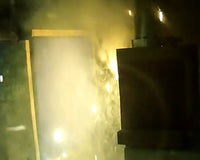IEEE 1584 v DGUV-I 203-077 – Comparing the Two Test Methods
Arc flash incidents pose serious risks to workers in various industries, making it crucial to accurately assess and select appropriate personal protective clothing and equipment (PPE). Two widely recognised methods for calculating the predicted incident energy and arc flash boundary as part of an arc flash study are IEEE 1584 and DGUV-I 203-077. Keep reading as we provide an in-depth comparison of these two arc flash assessment methods, highlighting their key differences and applications.
IEEE 1584: A Global Standard
IEEE 1584 stands as the global benchmark for arc flash assessment. This method is extensively used to calculate incident energy levels and determine arc flash boundaries. The results obtained from IEEE 1584 are instrumental in selecting PPE tailored to the specific hazards of an arc flash event. Additionally, the arc rating of PPE in the IEC world aligns with this method, relying on the IEC 61482-1-1 test, similar to ASTM F1959's Open Arc method.
The Open Arc test measures the incident energy at the test specimen, enabling the establishment of PPE arc ratings. IEEE 1584's global acceptance and its alignment with international standards make it a preferred choice for arc flash assessments in various industries.
DGUV-I 203-077: An Alternative Approach
DGUV-I 203-077, on the other hand, offers an alternative calculation method for arc flash assessment. This method was specifically developed to calculate arc energy levels for selecting PPE in accordance with IEC 61482-1-2's Box Test. Unlike IEEE 1584, DGUV-I 203-077 faces limitations in box size, rendering it unsuitable for placing monitor calorimeters to directly measure incident energy.
To address this limitation, DGUV-I 203-077 introduces the concept of Arc Protection Classes (APC). Two classes of protection, APC 1 and APC 2, are defined. The tests are conducted at 400 volts with an ejected arc originating from a small box. APC 1 employs a short circuit current of 4 kA, while APC 2 uses 7 kA.
Comparing the IEEE 1584 and DGUV-I 203-077
- Approach: IEEE 1584 employs a comprehensive approach to calculating incident energy levels, considering various factors such as system voltage, fault current, and working distance. In contrast, DGUV-I 203-077 focuses on defining protection classes based on a smaller box test.
- Global Acceptance: IEEE 1584 enjoys widespread global acceptance and recognition, making it the preferred choice for many industries. DGUV-I 203-077, while offering an alternative approach, may not be as widely recognized outside certain regions or industries.
- PPE Selection: Both methods ultimately aim to facilitate the selection of appropriate PPE. IEEE 1584 provides detailed incident energy calculations, allowing for a more precise selection of PPE, whereas DGUV-I 203-077 relies on protection classes, which may be less precise but still effective.
- Box Test Limitations: DGUV-I 203-077's limitation in box size prevents direct measurement of incident energy, potentially leading to less accurate results compared to IEEE 1584.
Conclusion
In the world of arc flash assessments, IEEE 1584 and DGUV-I 203-077 stand as two distinct methods, each with its strengths and limitations. While IEEE 1584 is globally recognised and offers a comprehensive approach, DGUV-I 203-077 provides an alternative method based on protection classes. The choice between these methods should consider the specific needs and requirements of the industry and region in which they are applied. Regardless of the method chosen, the paramount goal is to ensure the safety of workers facing the risks associated with arc flash incidents.
To discuss Arc Flash Standards in more detail feel free to contact sales@skanwear.com and lets book a conversation.




